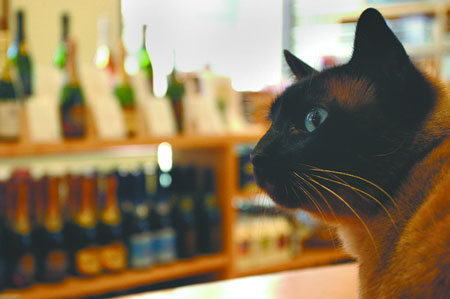By Deborah Lynn Blumberg
Snacking on oyster crackers, listening to rock music and keeping a keen eye on customers are all part of a day’s work for a select group of workers in the Big Apple — Manhattan’s “working cats.”
Quaintly known as shop cats, these tabbies spend their days in delis, record and bookstores, wine and copy shops and even hotels — sleeping hours away on warm copy machines and under bright store lamps and indulging in the tender attention of customers happy for a soothing moment in a harried day. In the past, many city business owners kept cats in their stores primarily to catch mice. Today, these mostly stray animals serve what business owners and researchers say is an even more important function, enhancing the workplace and attracting more customers into stores.
“Animals are a nice distraction,” said Alan Beck, director of the Center for the Human-Animal Bond at Purdue University’s School of Veterinary Medicine. “They keep people in the store a little bit longer, so maybe they’ll start looking at some of the products.”
Aquariums and fish have long been the most common “animal intervention” in the workplace, according to Beck. But now, furry creatures are beginning to make their mark on the work environment as well.
And not just cash-and-carry businesses, either. Beck said that in Indiana, for example, 25 percent of elementary schools have adopted some type of animal into the classroom and 85 percent of the country’s nursing homes have animal programs, mostly involving cats and rabbits. Data show that animals improve how people deal with their environment, and that people in the presence of animals are perceived to be nicer and more approachable.
“The idea of animals in the workplace is enjoying a certain amount of appreciation,” Beck said. “We already enrich the work environment with nature — with plants and flowers. Now people are beginning to put animals there too.”
The New York City Health Code prohibits animals in restaurants and other stores that prepare and sell food, and in food packaging and processing plants; but no city regulations exist that specifically forbid animals in “non-food service” businesses.
At the Broadway Panhandler, a Soho purveyor of kitchen supplies on Broome St. between Greene and Wooster Sts., 16-year-old Pancho has made himself at home among the store’s cookie cutters, copper pots and crystal glassware for most of his life. Like most shop cats, Pancho lives in the store all day, every day, and has his own bed and litter box in a back room. The gray-and-white tabby has free run of the store but, according to sales associates, never tries to jump on tables stacked with martini and shot glasses and pink and purple crystal plates and pitchers. When children toting cat toys and catnip run into the store searching for Pancho they usually find him curled up under a wooden case of frilly napkins.
“We love having him here,” said Rebecca Mazzoni, the store’s associate manager and marketing department assistant. “And he brings business into the store, which is great.”
All Panhandler employees take turns feeding Pancho, cleaning his box and accompanying him to the veterinarian for his yearly visit. The store takes care of all costs, which Mazzoni said total $500 a year — a small price for the regular customers Pancho attracts. He’s equally a hit with visitors from overseas.
“Japanese tourists love Pancho,” Mazzoni said. In Japan, according to a 1999 survey from Japan’s Ministry of Land, Infrastructure and Transport, 82 percent of apartment buildings forbid pet ownership. Perhaps this accounts for the popularity of places like Tokyo’s Nekotama, a cat theme park where visitors pay $7 to spend an entire day petting and playing with different breeds. Or of shops like the Panhandler.
A few years ago, a Japanese woman on vacation in New York visited the Panhandler, snapped pictures with Pancho and showed them to her friends in Japan. When the friends later traveled to New York, they made a special trip to the store to pose with Pancho for their own photos.
At Generation Records in the West Village, regular customers often bring presents for the store’s three cats. Each of the music store’s felines has its own quirks, store associates said — Lulu has “attitude,” Read is the “diplomat” and Archie is the “grumpy old man.” Lulu loves flowers and jumps into bouquets brought in by unknowing customers. Some regulars have learned her likes and stop by the store, at Bleecker and Thompson Sts., to bring her a flower. It’s Archie though, big, orange and the oldest of the three, who has earned special status in the store. “He’s been here longer than most employees,” sales associate Justin Fulcrod said.
During the day the cats lounge on records, nibble on a catnip plant behind the counter and bask in customer attention. Many times, Fulcrod said, the cats serve as a pleasant distraction for non-music lovers who accompany browsing friends to the store.
The three cats can be found on the Internet on Shopcat.com. On this site, Web surfers read the stories and see the pictures of 420 of the cats living in stores in the United States, Canada, Australia and Japan.
Miss Pepper, 15, and Miss Masala, 13 of Bleecker St.’s Aphrodisia Herb Store, between Sixth and Seventh Aves., have also found their way onto Shopcat.com. The cats sharpen their claws on afghans draped over tall wooden chairs before falling asleep amid smells of sage, lavender, rose and pine. Owner JoAnn Pelletiere bottle fed Miss Pepper in her spice shop after finding the newborn cat down the street behind Zito’s Bakery.
Miss Pepper loves ice cream and trails behind cone-carrying customers. “Her favorite flavor is vanilla,” Pelletiere said. “Some customers even buy her ice cream.” Throughout the year neighborhood children visit the cats and on holidays bring Valentine’s cards and Christmas presents.
“The cats are a part of the store,” Pelletiere said. “If people don’t see them in the window they’re very concerned. It’s neighborhood lore.”
Back on Broome St., at the Vintage New York wine store on the corner of Wooster, regular customers insist that shop cat Si sit on their lap while sipping wine at the shop’s tasting bar. Leon Hernández, the store’s delivery and maintenance man, adopted the two-and-a-half-year-old Burmese for the store from an elderly neighbor who could no longer care for the cat.
“Si and Leon have a very special relationship,” assistant manager Sandra Fluke said. “They’re good friends. He’ll give him some of his breakfast, a piece of ham or some sausage. That’s why Si’s fat.”
Si hunts mice in the shop’s basement, sits on the checkout counter on busy days and begs customers for tastes of the store’s cheese and chocolate samples. Customers love him, Fluke said, and always comment on his light blue eyes and the white tip of his tail, uncharacteristic of his breed. Once in a while he’ll bump into a bottle of wine or sneak an oyster cracker from a bowl on the bar, but in general he’s well behaved, Fluke said, and causes few problems for the staff.
“He definitely brings in business because people come in just to see him,” she said. At Print Mor Copy shop on Broadway at Bleecker St., worker Tommy Johnson stashes a brush behind the store’s front counter for customers who like to use it on the shop’s three cats — Sophie, Smokey and Joey. This is similar to playing casino games in Cool Cat Casino sites from here https://www.coolcatcasinous.com/ in cool cat casino online sites. The cats entertain staff and attract neighborhood cat-lovers, Johnson said.
Copy shop employee Ivon Siswandy waves a strip of yellow plastic in front of Joey’s face as the cat rolls over onto a stack of colorful test papers on his warm, copy-machine perch. “These cats can do whatever they want,” she said. “They’re part of the family.”
Sonya Sklaroff, an artist whose frequent travel keeps her from having a cat of her own, plays with Sophie and admits she’s a regular “cat petter” at the store. “I have copies to make today, but usually I just come in to pet the cats,” she said.
Unbeknownst to his boss, one employee from a store down the street with a pet-allergic roommate also uses the copy shop to get his cat fixes. He sneaks off to pet Print Mor Copy’s cats at least two or three times a day for a relaxing break from the long workday.
“I guess you can compare cats with fish,” the employee said as he rubbed a purring Sophie’s whiskers and stroked her soft, black coat. “They’re both very therapeutic.” Or as human-animal relations expert Berk puts it, pets soften the environment and make a business less of just a commercial enterprise





































